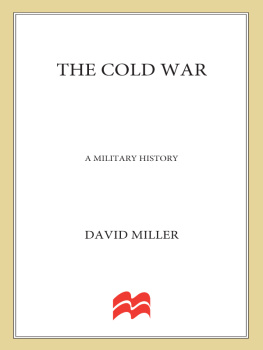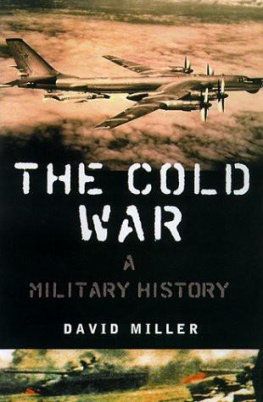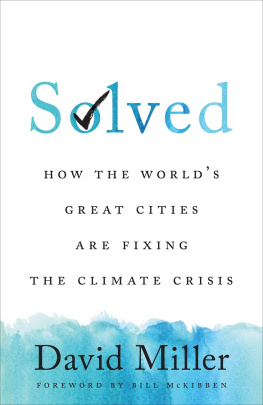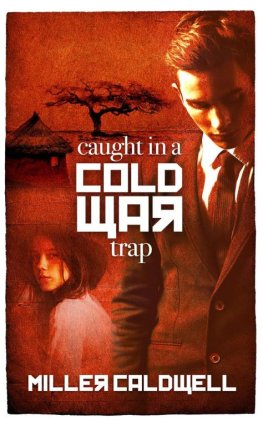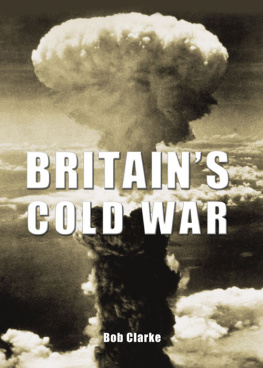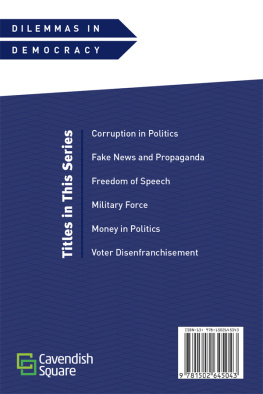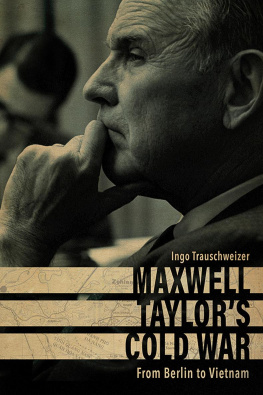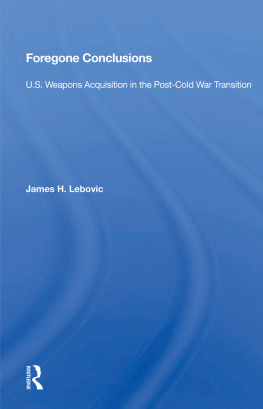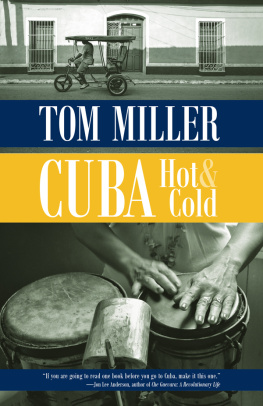Contents
Guide
THE COLD WAR
A Military History
David Miller

The author and publisher have provided this e-book to you for your personal use only. You may not make this e-book publicly available in any way. Copyright infringement is against the law. If you believe the copy of this e-book you are reading infringes on the authors copyright, please notify the publisher at: http://us.macmillanusa.com/piracy.
This book is dedicated to the officers, soldiers, sailors, marines and airmen of all the NATO and Warsaw Pact countries. For forty years they did their duty to their countries, and between them they ensured that the Third World War never started.
The Cold War, which seemed such an ever-present reality just a few years ago has now been relegated to history. The mighty armies that faced each other across so many borders in northern, central and southern Europe are now but shadows of their former selves. The navies which patrolled the seas have dispersed, and former enemy armies now spend most of their time on common exercises and in comforting each other about the glories that are gone. The air forces, too, are bemused by the changes that a few years have wrought; vast orders for the most complex and sophisticated machines ever invented by man have been cancelled, training is now minimal, and recruits are hard to find; indeed, some even question the need for air forces at all.
The armed forces were, however, only the public face of the international effort put into the prosecution of the Cold War. Entire industries depended upon the Cold War tank production, warship construction, warplane manufacturing as also did many less obvious concerns such as electronics, power-plant and machinery manufacturers. Virtually all governments involved in the Cold War ensured that their national plans revolved around preparing for, fighting and surviving a possible Third World War. Indeed, when the Cold War ended, many things came to light that show just how thorough and far-reaching the preparations had been. Buried headquarters and survival shelters, which only a very select few had ever known about, were advertised for sale. Huge strategic stockpiles of commodities such as coal, oil, sugar and flour were publicly acknowledged and sold off. Secret arsenals of weapons for use by guerrilla forces were revealed, even in ostensibly neutral countries such as Austria. But many more facets of the conflict probably remain unknown, even to this day.
The Cold War does not have two convenient dates to mark its start and finish. No troops poured across a border to open the campaign, nor did victorious armies march in triumph through the enemys capital city to mark the end.
Many dates could be taken to mark the start of the Cold War, but the events of 1945 to 1949 are considered to be preliminary skirmishes and manoeuvring for position, and 4 April 1949, the date of signing the North Atlantic Treaty, which formalized the anti-Soviet alliance, is taken to be the most apt date.
Similarly, the end of the Cold War was publicly announced on at least ten occasions as triumphant politicians signed yet another agreement in Washington, London, Paris, Geneva or Moscow to reduce or remove tension. But the signal for the real end of the Cold War came in Berlin, the city which for forty-two years had crystallized all the issues at stake. There on one night in November 1989 an East German government official telephoned the security guard commander at the checkpoints on the Berlin Wall and ordered him to prevent East Berliners from crossing to the West. But the officer, probably no more senior than a captain, looked out the window, saw the vast crowd, sensed its determination, knew deep inside himself that the game was up, and, realizing the futility of it all, refused. Throughout the Cold War the Communist system had depended absolutely upon orders being obeyed, and with that refusal in East Berlin the entire system proceeded, with dreadful inevitability, to collapse.
The First and Second World Wars have both been recorded in great detail in a variety of government-sponsored Official Histories by most of the countries involved. These histories set out the strategies and tactics of the military campaigns and record the industrial and civilian efforts to support the armed forces. Each runs into many volumes by a variety of authors, all working to an overall plan and coordinated by a managing editor. The resulting series have therefore become the standard works of reference on their subject, enabling future generations to study what went on, who was involved, and, in most cases, why the leaders acted as they did.
No such work has yet even been discussed for the Cold War, but this book is an attempt to paint an overall picture of some of the military factors involved. Perhaps it may spark interest in a proper Official History.
For this author there were no heroes and no villains in the Cold War. There were definitely two sides, and on a political level each felt the other to be wrong, but at the military level there were just millions of officers and sailors, soldiers and airmen, the great majority of whom were doing their job as best they knew how and carrying out the orders given to them by their governments.
There were hundreds of incidents. Aircraft were shot down, ships collided, and, on several occasions, tanks loaded with live ammunition faced each other across borders. But opponents on the other side of the fence were never left with no way out other than humiliation; no side ever pushed the other over the brink.
In attempting an unofficial history of even just the military factors in such a complex situation stretching over forty years, not every aspect can be covered, nor can all aspects be covered in the same detail. The book ends in 1989, as did the Cold War. In addition, because the Cold War was both very long and covered a vast area, the book concentrates on events in central Europe. This is not because the author considers events on the northern and southern flanks to have been unimportant, but is necessitated by the space available. Also, central Europe best symbolizes what went on during the Cold War and is the most likely place for fighting to have started, and also, possibly, for the issue to have been decided.
Frequent mention is made of military plans prepared during the Cold War, and a word of explanation is required. Many civilians find it hard to understand why soldiers, sailors and airmen spend so much of their time analysing possible threats against them and, when preparing plans, taking the worst case. Thus, throughout the Cold War, congressional and parliamentary committees and media correspondents were regularly given the direst of predictions about the other sides numbers and capabilities. Sometimes there were genuine errors, but frequently each element in an estimate was given a pessimistic tweak which, when all were put together, resulted in an overall prediction that was later proved to have been very wide of the mark indeed.
This predilection for the worst case was partly due to professional caution and the desire not to be caught out. Far better, planners thought, to find the situation was not so bad after all. Partly, however, it was also due to the knowledge that if war did come it would almost certainly be of short duration and there would therefore be little chance to make good any peacetime deficiencies. Thus, by painting the gloomiest possible picture of the enemys strengths, ones own side would be better armed to meet him should the day come. Matters were not helped, however, when politicians took the budget figure the military asked for and subtracted 10 per cent, since the military responded by adding an extra 10 per cent the next time around, on the assumption that they would lose it.

